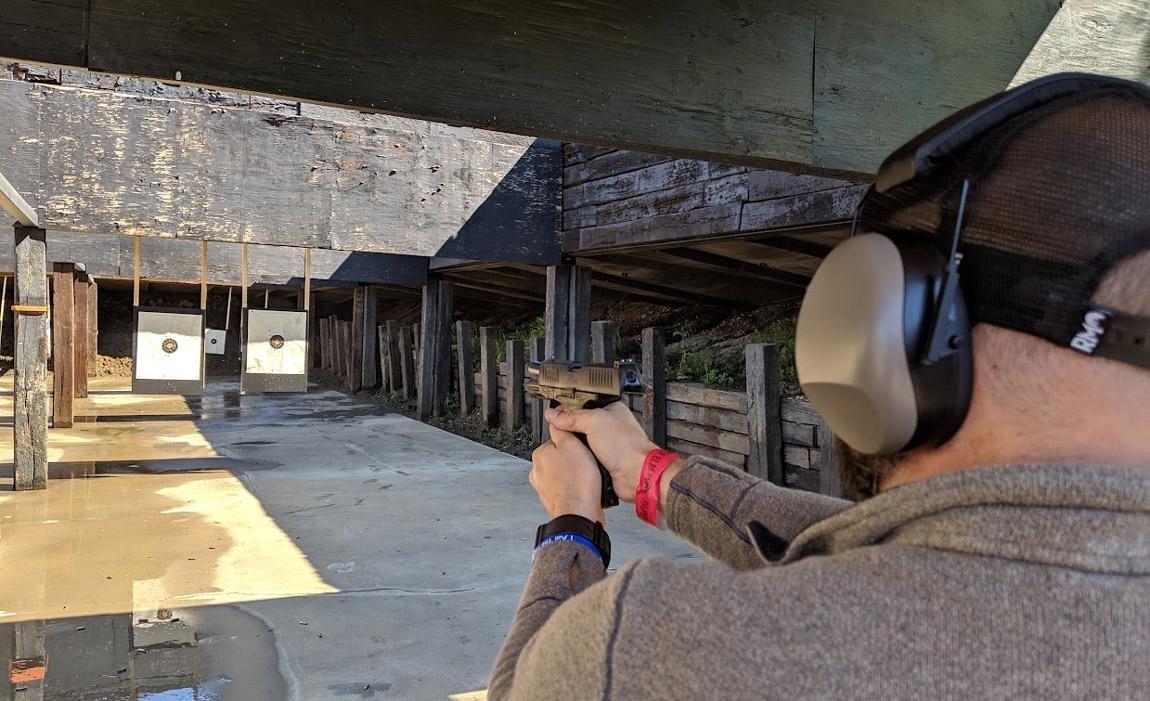Stepping into a shooting range for the first time requires proper preparation and confidence. Whether you're planning a guys night out, looking to build a new skill, or preparing for responsible firearm practice, understanding range protocols ensures a safe and successful experience that builds rather than undermines your confidence.
What Men's Health Issues Concern You Most?
- Professional instruction and range safety protocols eliminate common rookie mistakes that can embarrass you in front of other shooters
- Proper preparation prevents costly ammunition waste and equipment rental fees during your learning phase
- Understanding range etiquette builds instant credibility with experienced shooters and staff who can become valuable mentors
- Mastering basic safety commands and procedures allows you to focus on skill development rather than fumbling with fundamentals
- Smart first-time planning ensures you leave feeling accomplished rather than overwhelmed or discouraged
- Choosing Your First Shooting Range
- Essential Pre-Range Preparation
- Required Safety Gear and Clothing
- Critical Safety Protocols
- Understanding Range Commands
- Choosing Your First Firearm
- Building Confidence Through Instruction
- Managing Costs and Expectations
- Common Mistakes to Avoid
- Next Steps for Continued Development
Choosing Your First Shooting Range
Your range selection determines whether your first experience builds confidence or creates anxiety. Most areas offer indoor facilities, outdoor ranges, and specialized tourist venues, each serving different purposes for new shooters.
Indoor ranges provide climate-controlled environments with private booths and automated target systems. These facilities typically offer the most beginner-friendly atmosphere with professional staff trained to work with first-time shooters. Expect higher costs but superior instruction and equipment rental options.
Outdoor ranges deliver more space and natural sound dampening, often at lower costs through state facilities or private clubs. Many welcome non-members for daily fees and provide excellent learning environments with less crowded conditions during weekday mornings.
Tourist-oriented ranges in cities like Las Vegas specialize in first-time experiences with staff specifically trained for complete beginners. While more expensive, they excel at making nervous shooters comfortable and often provide exotic firearm options you won't find elsewhere.
Research range policies on rentals, ammunition requirements, and instruction availability. Most professional facilities prioritize safety over profit and maintain staff eager to help new shooters succeed.
Essential Pre-Range Preparation
Successful range visits start with proper planning and realistic expectations. Smart preparation prevents common first-timer mistakes and builds confidence from the moment you arrive.
Reserve your lane in advance, especially for weekend visits or popular facilities. Confirm rental firearm availability, ammunition costs, and any required documentation. Most ranges require valid identification and some form of safety briefing for new shooters.
Plan for 2-3 hours total time including paperwork, safety briefings, and actual shooting. Factor in potential equipment malfunctions or firearm malfunctions that require staff assistance - these situations provide valuable learning opportunities rather than embarrassments.
Budget appropriately for the complete experience. Expect $50-150 for range time, equipment rental, and ammunition depending on your location and firearm choices. Quality instruction costs extra but proves invaluable for building proper fundamentals.
Visit during off-peak hours when possible. Weekday mornings offer quieter environments where you can ask questions without feeling rushed or self-conscious around more experienced shooters.
Required Safety Gear and Clothing
Proper attire and protection equipment separate prepared shooters from obvious beginners while ensuring your safety and comfort throughout the session.
Eye and ear protection remain non-negotiable at every professional range. Many facilities provide basic equipment, but investing in quality gear improves comfort and protection. Shooting generates noise levels up to 140 decibels - equivalent to standing beside a jet engine.
Clothing choices affect your safety and comfort. Wear long pants, closed-toe shoes, and high-necked shirts to protect against hot brass casings that can bounce unpredictably. Avoid loose clothing that might interfere with firearm operation or catch ejected shells.
Bring hydration and snacks for longer sessions, especially during warm weather at outdoor facilities. Shooting requires focus and energy that diminishes quickly without proper sustenance.
Quality shooting gloves improve grip and prevent blisters during extended practice. Pack more ammunition than you think you'll need - running out early cuts your learning session short and wastes the range fee investment.
Critical Safety Protocols
Every professional range operates under strict safety rules that protect all shooters. These protocols become second nature with practice but require conscious attention for new shooters.
Treat every firearm as loaded regardless of what anyone tells you. This mindset prevents 99% of potential accidents and demonstrates competence to range staff and other shooters. Even when certain a gun is empty, maintain safe handling practices.
Keep your finger outside the trigger guard until you're ready to fire. Modern firearms only discharge when the trigger is pulled - maintaining proper finger position prevents accidental shots that can destroy targets, damage equipment, or worse.
Point the muzzle downrange at all times when handling any firearm. Never allow the barrel to point at anything you don't intend to destroy, including yourself, other people, or valuable equipment.
Know your target and what lies beyond it. Bullets travel far distances and penetrate multiple materials. Professional ranges provide safe backstops, but understanding this principle builds habits essential for future shooting situations.
Range safety officers monitor all activities and provide commands that ensure everyone's protection. Their instructions override everything else - immediate compliance keeps everyone safe and demonstrates your commitment to responsible shooting.
Understanding Range Commands
Range officers use standardized commands that all shooters must understand and follow immediately. These aren't suggestions - they're safety requirements that prevent accidents and injuries.
- "Eyes and Ears!" - Put on safety equipment immediately. Never ignore this command even if you think you're ready.
- "Range is Hot!" - Shooting may begin. Only handle firearms when you hear this command and you're positioned at the firing line.
- "Range is Cold!" - Stop shooting immediately. Step back from the firing line and do not touch any firearms until further notice.
- "Cease Fire!" - Emergency stop. Unload your firearm, open the action, and step away from the firing line immediately.
- "Down Range!" - Someone is going to set targets or perform maintenance. All firearms must be unloaded with actions open and placed on the bench.
These commands might feel intimidating initially, but they create the safe environment that allows you to focus on learning rather than worrying about safety. Range officers prefer over-cautious beginners to overconfident shooters who ignore protocols.
Choosing Your First Firearm
Most beginners should rent equipment rather than purchasing firearms before developing basic competence. Range staff can recommend appropriate options based on your experience level and physical characteristics.
Start with basic handguns or rifles rather than exotic options you've seen in movies or video games. Simple, reliable firearms teach fundamentals without complicated operating procedures that can frustrate new shooters.
Popular beginner options include 9mm handguns and .22 caliber rifles that offer manageable recoil and affordable ammunition. Avoid large caliber options that can develop bad habits or create negative associations with shooting sports.
Range staff can demonstrate proper loading, unloading, and basic operation before you begin shooting. Take advantage of this instruction - it's often included in rental fees and provides personalized guidance worth far more than the cost.
Consider handguns like a Glock 9 for their simplicity and reliability, but don't feel pressured to make purchase decisions during your first visit. Focus on learning fundamentals that apply to all firearms.
Building Confidence Through Instruction
Professional instruction accelerates learning and prevents developing bad habits that become difficult to correct later. Many experienced shooters wish they had invested in quality training from the beginning.
Ask questions freely - range staff and experienced shooters usually welcome helping beginners who show genuine interest in safety and improvement. Most ranges employ instructors specifically to work with new shooters.
Start with close targets at distances that guarantee success rather than challenging yourself with long-range shots. Building confidence requires consistent success that demonstrates your improving competence.
Focus on safety and consistency rather than perfect accuracy during first sessions. Proper fundamentals create the foundation for future improvement and separate serious students from casual participants.
Bring an experienced friend if possible, but ensure they understand proper instruction techniques. Well-meaning friends sometimes pass along bad habits or incorrect information that professional instructors must later correct.
Document your progress with target photos that show improvement over time. This evidence of advancing skills motivates continued practice and provides talking points when discussing your new interest with other men.
Managing Costs and Expectations
Shooting sports require ongoing investment in training, equipment, and ammunition. Understanding typical costs helps you budget appropriately and avoid sticker shock that might discourage continued participation.
Range fees typically run $15-30 per hour with equipment rental adding $20-40 depending on firearm types. Ammunition costs vary significantly but budget $20-50 for a productive first session.
Professional instruction costs extra but provides value that far exceeds the price. One-hour sessions with qualified instructors typically cost $50-100 but accelerate learning and prevent expensive mistakes.
Group sessions with friends can reduce per-person costs while creating social experiences that enhance enjoyment. Many ranges offer group discounts for parties of four or more shooters.
Plan for multiple visits before making equipment purchase decisions. Renting different firearms helps you understand personal preferences without committing to expensive purchases that might not suit your needs or interests.
Common Mistakes to Avoid
First-time shooters often make predictable errors that professional instruction and proper preparation can prevent. Learning from others' mistakes saves time, money, and potential embarrassment.
Rushing through safety briefings to get to the fun parts demonstrates poor judgment that concerns range staff. Pay attention to all instructions and ask for clarification when needed.
Choosing inappropriate firearms for your skill level creates frustration and can develop bad habits. Large caliber options might seem exciting but often overwhelm beginners with excessive recoil and noise.
Inadequate eye and ear protection causes discomfort that distracts from learning and can cause permanent damage. Quality protection enhances the experience by allowing you to focus on fundamentals.
Bringing friends who lack proper attitudes toward safety can ruin your experience and get your entire group ejected. Choose companions who share your commitment to following rules and learning proper techniques.
Setting unrealistic accuracy expectations leads to frustration and discouragement. Focus on safety and consistency rather than bullseye shooting during initial sessions.
Next Steps for Continued Development
Successful first range visits create foundations for lifelong shooting sports participation. Smart planning for future development ensures continued progress and increased enjoyment.
Schedule regular practice sessions rather than sporadic visits that require relearning basic skills each time. Monthly sessions maintain and build competence more effectively than irregular practice.
Consider formal training courses that cover specific skills like defensive shooting, precision marksmanship, or competitive disciplines. Structured learning accelerates progress beyond casual range visits.
Connect with local shooting communities through clubs, competitions, or training groups. Experienced shooters often provide mentorship and friendship that enhance your involvement in shooting sports.
Research different shooting disciplines to find activities that match your interests and goals. Options range from precision target shooting to practical defensive training and competitive sports.
Document your progress with scorecards, target photos, and skill assessments that demonstrate improvement over time. This evidence motivates continued practice and helps identify areas needing additional work.
Your first shooting range experience sets the tone for future involvement in firearms activities. Proper preparation, professional instruction, and realistic expectations create positive memories that encourage continued participation in shooting sports. Take your time, follow safety protocols, and focus on building solid fundamentals that will serve you well regardless of your future shooting goals.
Hey James Hills wants you to share this!

